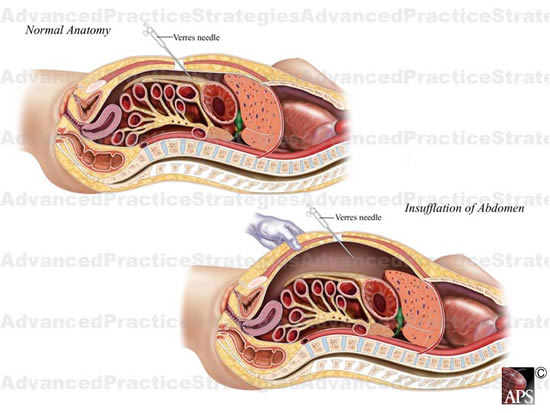Diagnostic Laparoscopy
A. The Condition. Diagnostic Laparoscopy is performed to evaluate the inside of your abdomen for a variety of reasons. You may be having this procedure done because of chronic abdominal pain without known cause, or to look for cancer, or for numerous other reasons.
B. Symptoms. As indicated above, the condition that you might have can be one of many, so there are no specific symptoms that go along with this procedure. You may have undiagnosed abdominal pain, endometriosis, intraabdominal blood loss, cancer, or many other possible disorders.
C. Diagnostic Laparoscopy. The surgeon will make about 3-4 small incisions in your abdomen. A port (nozzle) is inserted into one of the slits, and carbon dioxide gas inflates the abdomen. This process allows the surgeon to see inside of your abdomen more easily. A laparoscope is inserted through another port. The laparoscope looks like a telescope with a light and camera on the end so the surgeon can see inside the abdomen. Surgical instruments are placed in the other small openings and used to explore the abdomen. The surgeon may take biopsies of specific sites if something unusual is found. The surgeon also may cut scar tissue that has entrapped organs. After this has been accomplished, the carbon dioxide is released out of the abdomen through the slits, and then these sites are closed with sutures or staples, or covered with glue-like bandage and steri-strips.
D. Nonsurgical Treatment. There are other tests which may be used to diagnose your problem, such as CT scans or endoscopy. Your doctors will discuss with you what your best option will be.
E. Risks. The primary risks of diagnostic laparoscopy are:
- Infection of the skin at one of the small ports sites
- Bleeding within the abdomen
- Postoperative ileus (the intestines slow down/stop working for several days)
- Persistent abdominal pain
F. Expectations
1. Before Your Operation. Diagnostic laparoscopy usually is an elective procedure. The preoperative evaluation might include blood work, urinalysis, and abdominal ultrasound, and an abdominal CT scan. In some cases, endoscopy and/or x-rays of your bile duct may be performed. If you smoke, then you should stop immediately. If you are taking blood thinners (for example, aspirin, coumadin, or Plavix), then you will need to stop these one week prior to your procedure. Your surgeon and anesthesia provider will review your health history, medications (including blood thinners), and options for pain control.
2. Your Recovery. You usually can go home the same day after a diagnostic laparoscopy. You will be given medication for pain. You should limit your activity to light lifting (no more than 15 lb) for one month.
3. Call Your Surgeon if you have one or more of the following:
- Severe pain
- High fever
- Odor or increased drainage from your incision
- No bowel movements for three days
G. Pertinent References
Frantzides CT, Carlson MA, eds. Atlas of Minimally Invasive Surgery. Philadelphia: Saunders Elsevier, 2009.

